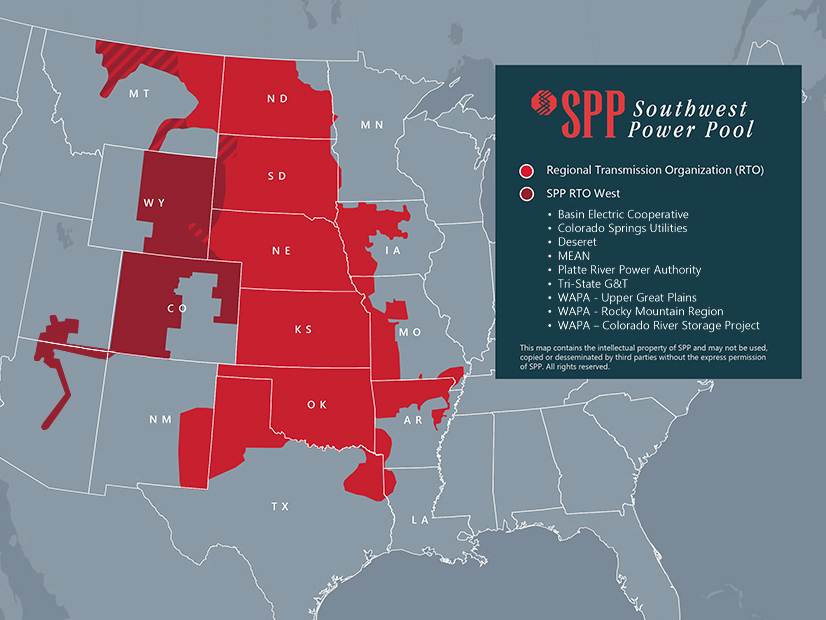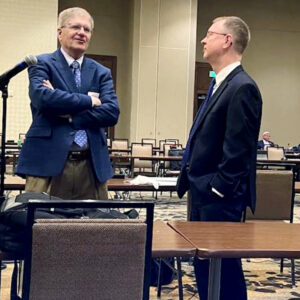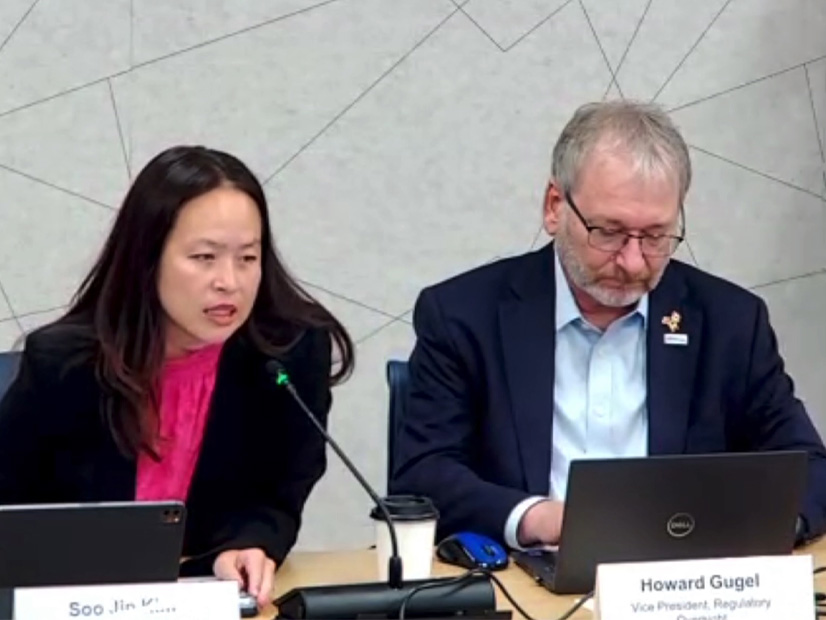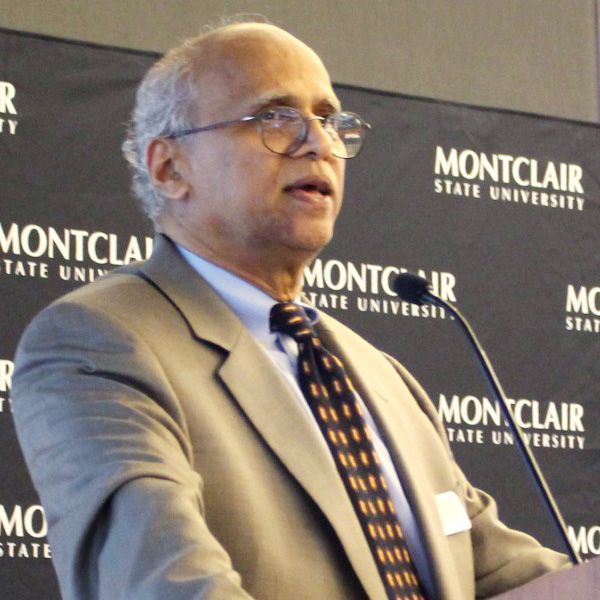CEO Sugg Warns of ‘Serious Challenges’ Facing the Region
AURORA, Colo. — SPP CEO Barbara Sugg warned the RTO’s Board of Directors and stakeholders last week that the grid operator faces new and stronger headwinds, even as it met its corporate goals’ first-quarter milestones.
In delivering her president’s report to open the May 7 quarterly meeting, she said, “I tell people all the time what a great time [it is] to be in the electric utility industry, but it’s not without challenges.”
Sugg then listed those challenges: “significant” load growth in recent years and more “unprecedented” growth in the foreseeable future; still more variable energy resources in the generation fleet and interconnection queue; the transition to clean energy resources outpacing the technologies needed to support them for reliability; performance issues with traditional resources that have historically been “extremely dependable and responsive”; transmission constraints; struggling to get new transmission built in a timely fashion; and a backlog of generators with interconnection agreements that are not yet online.
“And if that wasn’t enough, extreme weather events are becoming more the norm than the exception,” Sugg said. “I say all this to say that what got us here will not get us there.
“We’re facing serious challenges in the region. We must continue to work together to not only understand these challenges, but remain committed to resolving them.”
SPP’s corporate goals are tied to its strategic plan. Mitigating resource adequacy risks is tied for the No. 1 goal with cybersecurity, and no wonder: The grid operator has issued five resource or conservative operations advisories since early March, the latest because of threats from solar storms.
The RTO’s other goals are enhancing extreme weather event readiness, optimizing the generator interconnection queue’s processing, advancing innovative transmission policies and continuing the western expansion.
“A vital element of these goals is to focus on affordability,” Sugg said. “We are still looking for opportunities to increase value and decrease costs. … We are below budget so far this year. I’m knocking on wood in large part due to process improvements and exceptional negotiating skills. Of course, there are always things that come up throughout the year that may or may not have been on our radar or in our budget, but we’re keeping a focus on affordability.”
As if to emphasize the complexities ahead for SPP, the U.S. Department of Energy on May 8 released a list of 10 proposed transmission corridors that could be eligible for a share of $2 billion in federal loans and special permitting under FERC’s backstop siting authority. (See related story, On the Road to NIETCs, DOE Issues Preliminary List of 10 Tx Corridors.)
Most of the National Interest Electric Transmission Corridors (NIETCs) lie squarely in SPP’s current and planned footprints. They include the 645-mile Delta Plains and 780-mile Midwest-Plains corridors, both of which would link with MISO. The Northern Plains corridor could solve congestion issues in the Dakotas and Nebraska, while two more in New Mexico and Colorado could improve ties between the two major interconnections.
FERC on May 13 will unveil its plan to accelerate long-distance transmission line development to meet rising power demand and bring a backlog of planned clean energy projects to the grid.
Apparently, it’s nothing SPP can’t handle. The grid operator says it will evaluate the order, DOE’s NIETC notice and other “pertinent” rulings in coordination with its members and the Regional State Committee, which comprises state regulators.
“SPP is hopeful these initiatives will align with our strategic goals to continue removing the generator interconnection backlog and developing a long-range consolidated planning process,” spokesperson Meghan Sever said.
Bylaw Changes for RTO West
SPP’s membership unanimously approved recommended bylaw changes from the Corporate Governance Committee related to the RTO’s western expansion and board compensation during a special member meeting.
The CGC said the revisions to SPP’s bylaws and its membership are necessary to expand the RTO into the Western Interconnection. They include increasing the Strategic Planning Committee’s membership, considering diversity between the two interconnections when selecting organizational group participants and expanding terms specific to the Western Area Power Administration’s Upper Great Plains to the agency’s other regions.
Separately, the board approved a package of 16 tariff revisions that include establishing a Western balancing authority area and managing transactions across the DC ties’ 510 MW of bidirectional capacity between the two interconnections. Settlements will be based on transmission service reservations during the market’s first four years. After that, they will be based on transmission congestion rights.
“We will use a single-market optimization using these DC ties to bring value across both the West and the East, with the goal to bring price convergence across the DC ties,” said Bruce Rew, SPP’s senior vice president of operations.
Lloyd Linke, WAPA-UGP’s regional manager, abstained from the Members Committee’s unanimous vote, saying he “fully supports” the changes but that the agency wants to keep its options open in addressing potential protests at FERC.
American Electric Power, Evergy and the Natural Resources Defense Council’s Sustainable FERC Project also abstained.
SPP has been working since 2020 with Western parties, some already members in the East, interested in joining the RTO: Basin Electric Power Cooperative, Colorado Springs Utilities, Deseret Power, Municipal Energy Agency of Nebraska, Platte River Power Authority, Tri-State Generation and Transmission Association, and three WAPA divisions.
The prospective members would add Utah and Arizona to SPP’s 15-state footprint.
SPP’s RTO West is a “true expansion,” in the words of board Chair John Cupparo. Markets+ is a contract service funded by its participants. RTO West is targeted to go live in April 2026.
The approved bylaw changes for directors’ compensation will increase their annual retainer from $95,000 to $125,000. The CGC said the increase keeps SPP’s board compensation competitive and helps attract top talent.
The committee said it slightly modified the compensation framework to eliminate fees paid for special board assignments, board advisory or liaison support, assigned meetings, and the board/committee meeting fee. Board members will receive additional fees for participating on nine committees and task forces, increasing their compensation by 6 to 15%.
Sugg said the board’s total 2024 compensation of $1.54 million is 11% above forecast. She said a compensation consulting firm recommended an even greater increase.
“You all are very well aware and witness on a near-daily basis just how engaged the board is and how collaborative they are and working with all of you,” she told stakeholders.
The CGC will again review the compensation policy in 2025, Sugg said.
SPP, SPS Reviewing April Outage
Sugg told the board and MC that SPP is reviewing a small, local load-shed event in New Mexico and will bring a full report to the Markets and Operations Policy Committee’s meeting in July.
The April 28 outage lasted for about two hours and represented about 3% of the area’s load. Southwestern Public Service, the local transmission owner, said about 1,000 customers were without power.
“As with all operational events, we take these very seriously and are working through the after-action steps,” Sugg said. She said SPP and SPS staff, along with the Operating Reliability Working Group, are involved in the review.
SPS said in a statement it was directed to reduce load to address voltage issues in the southern portion of its service territory.
“The specific drivers behind this event and steps to minimize recurrence remain a topic of discussion between SPS and [SPP],” it said.
2023 Annual Report Released
SPP has released its 2023 annual report highlighting the previous year’s accomplishments, which resulted in $3.6 billion in benefits to its members and a 20:1 cost-to-benefit ratio. Sugg said lower gas prices, “substantial” load growth and an increase in wind energy were the primary drivers.
Using a calculation vetted several years ago by stakeholders, the grid operator found members realized $2.25 billion in benefits from the markets and a combined $1.88 billion from transmission and operations and reliability. That was partially offset by $524.6 million in the transmission revenue requirement’s costs.
“We certainly are delivering significant value to the region,” Sugg said.
Dowling, Janssen Leave SPP
Sugg led standing ovations for Midwest Energy’s Bill Dowling and Kelson Energy’s Rob Janssen, who were both attending their last board meeting.
Dowling has announced his retirement, and Janssen’s company is selling off its interest in Dogwood Energy, a 665-MW gas-fired generator in Oklahoma that serves as its only resource in SPP.
“Lots of people come and go from this committee, but we would be remiss if we didn’t stop and recognize the fixtures, those people that really helped us become the organization that we are,” Sugg said. “We’ll miss both Bill and Rob.”
Dowling and Janssen have both served as MOPC’s chair and spent more than 20 years on the MC. Dowling was also a founding member of the Regional Tariff Working Group.
“I asked [Bill] if I could blame him for the 8,000 pages in our tariff, and he said, ‘No. Only the first 3,000 pages,’” Sugg said.
Board Approves RSC Revisions
The board and MC approved three RSC revision requests that commissioners previously endorsed unanimously — as they did for all seven of their voting items — during their May 6 meeting:
-
- RR607 implements policy changes to the safe harbor provisions approved last October to provide more flexibility for market participants. The measure replaces the original 125% peak load criterion to not exceed the transmission customer’s projected system peak responsibility multiplied by the higher of 125% or the sum of 110% and the current planning reserve margin percentage. The policy reflects SPP’s recent establishment of a PRM.
- RR605 defines an authorized outage, adds requirements for resources’ availability during both the summer and winter seasons (unless on an authorized outage), and helps load-responsible entities and generation owners better understand when to submit RA capacity when providing workbooks to meet the RA requirement.
- RR616 ensures any outage not approved by the SPP balancing authority and not an outside management control event is accounted for in performance-based accreditation. Three renewable energy interests abstained from the MC advisory vote, with the Sustainable FERC Project’s Christy Walsh expressing concerns over SPP’s “piecemeal” approach to RA that could lead to additional tariff filings at the commission.
The board’s consent agenda resulted in the approval of the 18-person industry expert pool that will judge bids for competitive projects within the SPP footprint. A panel of three to five experts will be chosen from the pool for each competitive upgrade. Sixteen of the members were renewed, and two new members were added.
Other items on the consent agenda included:
-
- RR555, which implements two recommendations FERC made to SPP after the 2021 winter storm: that transmission operators and balancing authorities include new guidelines in their emergency operating plans to facilitate rotating load shed and protect critical gas infrastructure.
- An out-of-cycle request by Evergy Kansas Central to re-evaluate a 138-kV terminal upgrade near Wichita.
- Withdrawing a WAPA-UGP 345/230-kV transformer project in Fort Thompson, S.D. WAPA’s estimate of $59.17 million exceeded the $36.34 million variance bandwidth and would have delivered the project 10 years late.
- Approval of a $35.95 million refined cost estimate for SPS’ Potter County 345/230-kV transformer project. SPS’ estimate exceeded the $35.91 threshold, but staff said approving the economic project will allow the company to proceed and economically benefit the region.



